Italy - STEFANO FIORESI
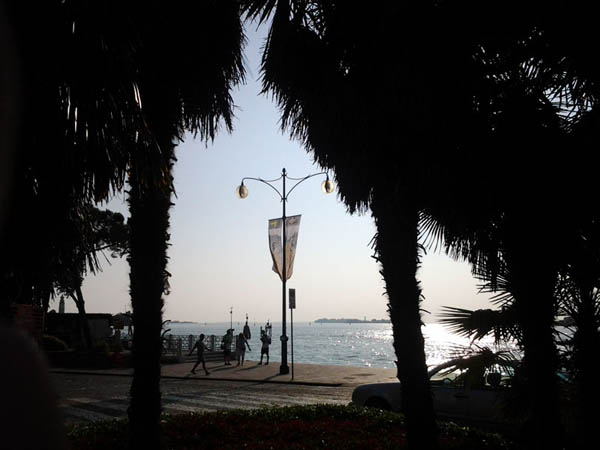
Homo viator
I had defined the Modenese artist Stefano Fioresi as the modern version of the Nineteenth Century flâneur, who strolls along the streets and pavements of metropolitan cities drawing on the existing symbolic and communicative reserve in order to shape his own contemporary art study. A frenetic, erratic and curious flâneur, who wanders through the city with no fixed itinerary of streets, yet who is able to draw sense and meaning from his own tracks.
After walking the 800 km of the Way of Saint James, the artist literally donned the ancient vestments of the homo viator, the figure of the mediaeval pilgrim who travelled on foot, from city to city and town to town, heading towards the destination, gaining knowledge of information, and distant ways and customs.
The motive for the pilgrimage is expressed by Fioresi, in the central part of the banners for OPEN 16, reproducing two pictorial works that interpret the Way of Saint James: two pairs of wayfarers are portrayed moving along a path painted in golden tones, in contrast with the black and white background of the collage, to emphasise the preciousness, beauty and uniqueness of this mystical, illuminating experience.
The status of pilgrim necessarily brings with it symbols that are visualised in the photographic cuttings of the upper part of the banners. Most importantly, there is the seashell, sign of life, rebirth and purification, and a clear reference to the condition of pilgrims who sewed them onto their clothes and hats - and still seen nowadays on the rucksacks of modern pilgrims - as testimony of having completed the Way as far as Finisterre, where this type of shell could be found on the beach. They are also called “cappesante”, or “holy scallops” in Italian, since they were food that the pilgrims would eat on the Galician coasts, keeping the shell as a souvenir.
Another symbol picked out is the faithful travelling companion, the Flecha Amarilla (yellow arrow) which shows the way to Santiago di Compostela and Finisterre. It was first drawn by Don Elías Valiña, parish priest of Cebreiro, in 1984 with yellow paint left over from road works. The Flecha Amarilla, set vertical, is traced out by hand by Fioresi in the lower part of the banner, to unify the pictorial work and the photographic tiles below which reproduce the textures of various paths and gravel photographed by the pilgrim artist along his route. These yellow arrows are an implicit reference to the road markings which make up the artist’s usual image gallery, to reconnect this design piece within his entire poetic creation, in a short circuit of literal and poetic references on the theme of travelling and roving.
Text by Chiara Canali
Italy - CLAUDIA DANIELI
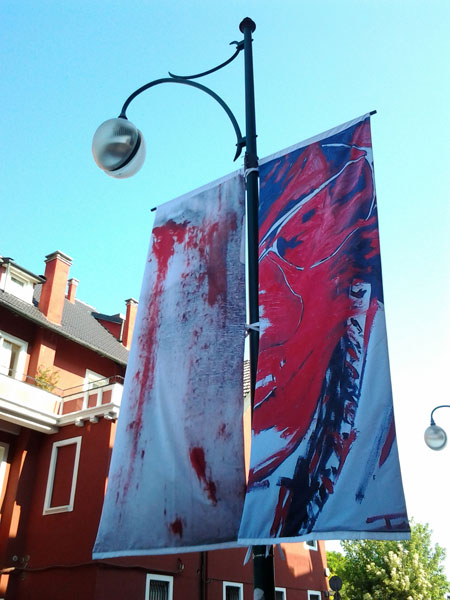
Claudia Danieli approaches the canvas as though she were in the ring with her most formidable opponent: herself. Her works have an impact on the eyes and the senses. The extreme realism of the portraits is violated by the colour which is very often red: bright red, like red meat, red passion, a creative flow of vitality.
Colour must never cease to flow in the artist, otherwise frustration gains the upper hand over instinct. The impulsive act is closely connected to anger which becomes creativity, exploded and not imploded.
The artist takes all her impulses, her dynamic alter ego, and throws them onto the canvas with expressionist style, in an attempt to correct the static nature of reality. There is a duplication of the corporal nature, both in the choice of the subject of the portrait (which encompasses the ability to render the soul of the person depicted) and in the violence of the act of painting.
The strong visual impact is not dramatic, but dynamic.
Despite the strength of the colour on the canvas, the artist wins the battle with an unspoken agreement between herself and her unconscious: an agreement of pure creativity.
Text by Sign On Art
Italy - CASAGRANDE & RECALCATI
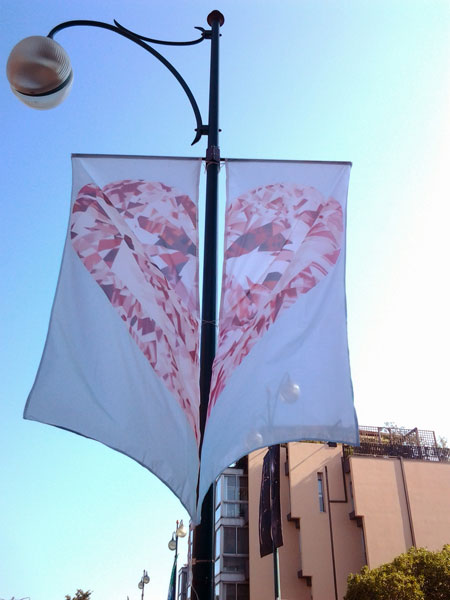
The seduction of beautiful flags
I discovered the joyful creativity of Sandra and Roberto in the mid Eighties, at School, during the lessons on “History of Criticism”, a dreamy hermeneutic subject that gave us the opportunity to embark on long, free imaginary journeys into the depths of space and time. The writer who introduced us was Baudelaire and his city of flâneurs.
They are both rather anarchic free children of the revolution of 1968; they love to experiment with the subtle art of relating the inexhaustible, happy complexity of the human condition, delving into its deepest folds, into the invisible dark shadows of everyday reality. They use the hyper-realistic pop technique of out-of-scale, zoom and blow-up, just to penetrate with forever renewed amazement - for instance - in the gentle inner space of a flower (their Master and our great mutual friend, Vittorio Locatelli, had always enchanted us by exploring the world of a tulip...).
Their sensitive and refined eye loves to observe closely the elegant and harmonious movement of “limit animals” that seem to be jokes played by the Creator, such as flamingos with their slender tapered legs, long necks and contorted beaks, protagonists, ten years ago, of the grand “aviary” of the Caffé delle Logge in Prato. They dance lightly, tracing orbits without edges in the invisible element Air. It is a keen eye that gladly loses itself with enchantment in the smooth whirls of colour of gigantic flowers (as in their latest exhibition at MyOwnGallery in Milan). Or again, that finds its congenial environment in the dimension of a huge floating city in constant movement, ploughing through the unstable liquid expanse of the element Water (and then it becomes a gentle narrative art on board the great ships of Costa Cruises). Or lastly (as here in Venice), Sandra and Roberto entrust their refined design of an intangible jewel - heart 2 heart - to the beautiful flags fluttering in the air, to present their enthralling message of love.
Text by Marco Dezzi Bardeschi
Italy - GAETANO K. BODANZA
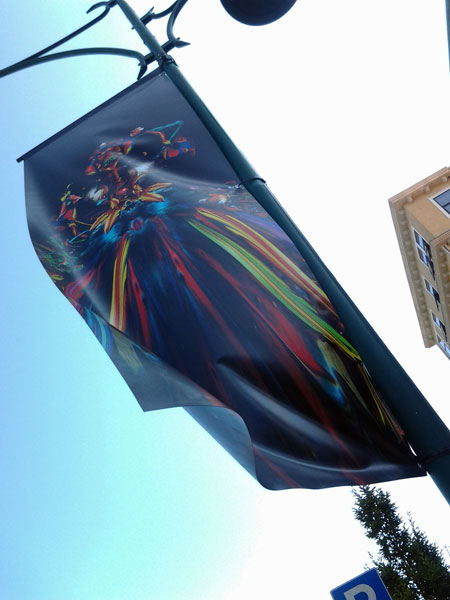
Bodanza chooses to represent a combined narrative, a kind of epic in acrylic paints where the heroes and the second leads tell the story and chronicle of popular cultures. The main rule adopted by the eye is the short circuit, cohabitation causes the epic tone of the scenarios to explode, the panoramic view opens up to the cinemascope invented by the artist. A rambling and unclassifiable pop, with a film-like soul but pictorial results, curious to experiment using forms of language that are pop’s means of action and privileged emotion.
Characters with an overwhelming imaginary vision, that seem to come straight out of the paint tube, so dense is their substance; they are then shaped by digital technology to leave no smears and prefer a formal virtuosity with an air of plastic and resins in the creation of unusual sinister and at the same time burlesque creatures.
The picturesque landscapes that he represents are crowded and teeming with shapes, gestures and looks. Removed from the context of a crowd in which we have to seek them out and recognise them, here they stand out against saturated monochrome backgrounds, like passport photos from an alien world. From the crowd of hominids, insects, cartoon characters and toys Bodanza extrapolates brightly coloured portraits which, from the magma of traditional painting, become a part of large digital canvases and take tangible shape in large fibreglass sculptures. There is nothing realistic about the alien characters that he represents, but they look at us with piercing eyes and dialogue with us through gestures and expressions from which we could draw a curious handbook about human feelings.
His personal trait is that he acts within a reality that is much more extensive than the real world, recreating stories as though everything were perfectly plausible. Everything becomes necessary and credible in the world at pop temperature, the subject/object takes up the spotlight of its gaze and produces chemical energy, an analysis of reality, new dialectical boundaries.
The coexistence of language is the other focal point for Gaetano Bodanza. There has never been a predetermined border, drawing and painting interact with the processing of digital software, sculpture experiments with materials and technologies. However the work seeks the limit of its development status, highlighting the deceptive nature of technique, that virtual theatre in which to invent worlds through other worlds.
Text by Chiara Moro
Italy - ALVISE BITTENTE
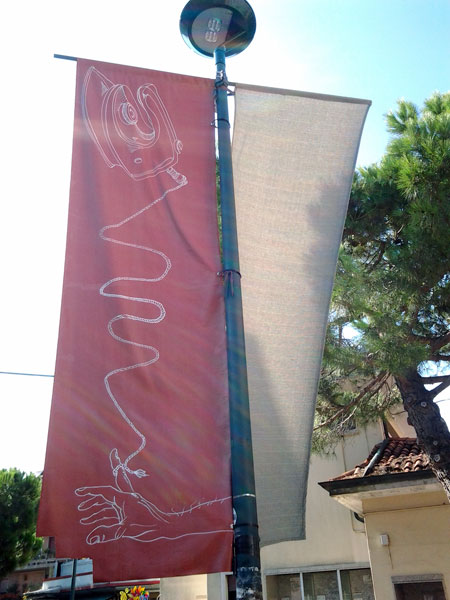
…a flag waves on the deck… But now there’s no deck, no link, no waving standard or banner, not even a ragged flag, nothing left to advertise. The work is supported by a rubberised canvas material, almost a bicycle inner tube, but it does not inflate anymore because the flag has become flat, without air, because there’s no wind, neither fore nor aft. Bereft of its function, the flag is becalmed, one side anchored, the other ironically ironed, pleated, captured like a yoyo or a helium balloon frozen in its movement, enchanted in a frame with nothing more to display than its own immobility.
Text by the artist